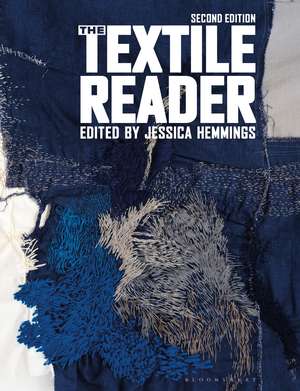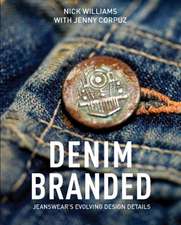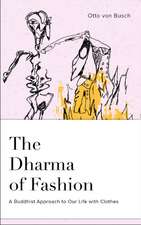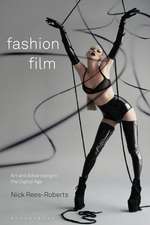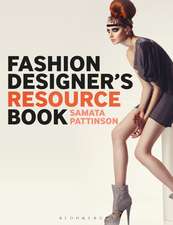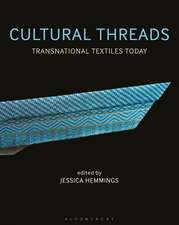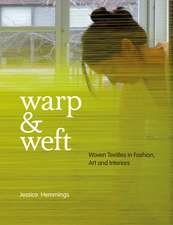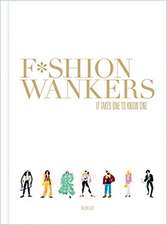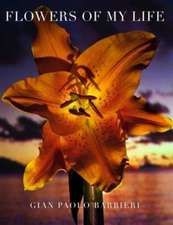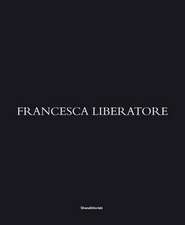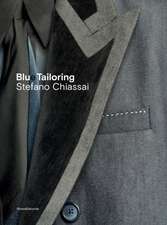The Textile Reader
Editat de Professor Jessica Hemmingsen Limba Engleză Paperback – 8 feb 2023
| Toate formatele și edițiile | Preț | Express |
|---|---|---|
| Paperback (1) | 259.64 lei 3-5 săpt. | +74.09 lei 6-10 zile |
| Bloomsbury Publishing – 8 feb 2023 | 259.64 lei 3-5 săpt. | +74.09 lei 6-10 zile |
| Hardback (1) | 714.12 lei 3-5 săpt. | |
| Bloomsbury Publishing – 8 feb 2023 | 714.12 lei 3-5 săpt. |
Preț: 259.64 lei
Preț vechi: 293.61 lei
-12% Nou
Puncte Express: 389
Preț estimativ în valută:
49.69€ • 53.95$ • 41.74£
49.69€ • 53.95$ • 41.74£
Carte disponibilă
Livrare economică 02-16 aprilie
Livrare express 18-22 martie pentru 84.08 lei
Preluare comenzi: 021 569.72.76
Specificații
ISBN-13: 9781350239845
ISBN-10: 1350239844
Pagini: 372
Dimensiuni: 189 x 246 x 18 mm
Greutate: 0.81 kg
Ediția:2
Editura: Bloomsbury Publishing
Colecția Bloomsbury Visual Arts
Locul publicării:London, United Kingdom
ISBN-10: 1350239844
Pagini: 372
Dimensiuni: 189 x 246 x 18 mm
Greutate: 0.81 kg
Ediția:2
Editura: Bloomsbury Publishing
Colecția Bloomsbury Visual Arts
Locul publicării:London, United Kingdom
Caracteristici
Includes a wealth of diverse material, drawn from the 19th century to the present day, including authors' statements, and short stories, as well as critical writings
Notă biografică
Jessica Hemmings is Professor of Craft at HDK-Valand, University of Gothenburg, Sweden. She is Visiting Professor with the Doctoral School of Moholy-Nagy University of Art and Design in Budapest, Hungary (2022), the Rita Bolland Fellow at the Research Centre for Material Culture, the Netherlands (2020-2023 and a member of the editorial boards of Textile: The Journal of Cloth & Culture and Craft Research. Jessica is the author of Yvonne Vera: the Voice of Cloth (2008), Warp & Weft (Bloomsbury, 2012), and the editor of In the Loop: Knitting Now (2012) and Cultural Threads (Bloomsbury, 2014).
Cuprins
Introduction1. Touch1. Victoria Mitchell (1997) 'Textiles, Text and Techne'2. T'ai Smith (2014) 'The Haptics of Optics: Weaving and Photography' (excerpt)3. Elaine Igoe (2010) 'The Tacit-Turn: Textile design in design research'4. Pennina Barnett (1999) 'Folds, Fragments, Surfaces: Towards a poetics of cloth'5. Catherine Harper (2005) "Meditation on Translation and Seduction"6. Isak Dinesen (1957) 'The Blank Page'7. Birgitta Nordstro¨m (2020) 'How do you Footnote a Smile? One Dialog about Two Extremes of Textile Research' 2. Memory8. Jenni Sorkin (2000) 'Stain: On Cloth, Stigma, and Shame'9. Isabel Cristina González Arango (2013/2021) 'Claiming the Right to Memory, Stitch by Stitch: The experience of the Costurero Tejedoras por la Memoria de Sonsón' (the Sonsón Memory Sewing Group) 10. Marit Paasche (2019) 'We Are Living on a Star' (excerpt)11. Roger Hutchinson (2011) The Silent Weaver (excerpt)12. Faith Ringgold (2019) 'Interview: Faith Ringgold and Hans Ulrich Obrist' (excerpt)13. Sue Prichard (2005) 'Collecting the Contemporary: Love Will Decide What Is Kept and Science Will Decide How It Is Kept'14. Sarah Scaturro (2020) '(Im)mortal Fashion: Iris van Herpen's "Skeleton" Dress'15. Takahashi Mizuki (2019) 'Hong Kong's Textile Industrial Heritage: Transformations to a place of weaving creative experiences for all'3. Structure16. Gottfried Semper (1851/1989) 'The Four Elements of Architecture' (excerpt)17. Philip Beesley (1999) 'Reflexive Textile'18. Otti Berger and Judith Raum (1930/2019) 'Fabrics in Space' & 'Weaving and Interior Design': Voice-over for the video Discussion of Material (excerpt)19. Catherine de Zegher (1997) 'Ouvrage: Knot a Not, Notes as Knots'20. Gilles Deleuze & Felix Guattari (1987) '1440 The Smooth & the Striated' (excerpt)21. Sabrina Gschwandtner (2008) 'Knitting Is.'22. Kate Goldsworthy, Rebecca Earley and Kay Politowicz (2019) 'Circular Speeds: A Review of Fast & Slow Sustainable Design Approaches for Fashion & Textile Applications' 4. Politics23. James Fenimore Cooper (1843) Autobiography of a Pocket Handkerchief (excerpt)24. Arthur C. Danto (2006) 'Weaving as Metaphor and Model for Political Thought'25. Sarat Maharaj (1991) 'Arachne's Genre: Towards Intercultural Studies in Textiles'26. Susan S. Bean (1989) 'Gandhi and Khadi, the Fabric of Indian Independence' 27. Pamela Johnson (2011) '100% Cotton'28. Galina Kareva (2011/2021) 'Ivanovo's Agitprop Textiles: Design and Inscriptions'29. Elisa Auther (2008) 'Fiber Art and the Hierarchy of Art and Craft, 1960-80'30. Julia Bryan-Wilson (2017) 'Queer Handmaking' (excerpt)31. Charlotte Perkins Gilman (1892) 'The Yellow Wallpaper' (excerpt)5. Production32. Roger MacDougall (1951) The Man in the White Suit (excerpt)33. Maria Fusco (2018) 'machine oil smells sweet (piecework)'34. Melanie Miller (2007) 'The Romance of Modern Manufacture: A Brief History of Embroidered Embellishment'35. Sadie Plant (1997) Zeroes + Ones: Digital women + the new technoculture (excerpt)36. Ele Carpenter (2010) 'Open Source Embroidery: Curatorial Facilitation Of Material Networks'37. Boatema Boateng (2011) 'Why Should the Copyright Thing Work Here?' (excerpt)38. Sarah Rhodes (2015) 'Contemporary textile imagery in Southern Africa: a question of ownership' 39. Yosi Anaya (2016/2021) 'Heneque´n, A Green Fiber with a Complex History in Yucatan'6. Community40. Nathaniel Hawthorne (1850) The Scarlet Letter (excerpt)41. Joseph McBrinn (2021) 'Needlework and the creation of masculinities: "The prick" of patriarchy' (excerpt)42. Jools Gilson (2012) 'Navigation, Nuance and half/angel's Knitting Map: A series of navigational directions.'43. Rose Sinclair (2020) 'Tracing Back to Trace Forwards: What does it mean/take to be a Black textile designer'44. Alice Walker (1973) 'Everyday Use' 45. Ursula K. Le Guin (1984) 'The Trouble with the Cotton People' (excerpt)
Recenzii
This Reader is not merely a collection, but more of an interrogation that speaks from the past to the future. With this in mind, The Textile Reader is not a 'page turner', but a constant companion, a new friend that has been there and done that, and thus offers the reader a platform from which to consider and develop the future of the discipline.
[T]he pieces are well chosen: they read as though they were selected because someone likes them and finds them interesting, and this gives the selection personality and integrity ... Its greatest value is, however, in its general sense of opening out the genres and the way in which it creates a space for different types of writing on textiles to be considered on an equal footing.
Will undoubtedly become a key resource for all those interested in considering the location of textile practice, but also for those who seek to understand and challenge textile practice's perceived inferiority as a mode of practice.
An ideal foundational text to give an overview of the broad field of Textile Research. It allows students access to a range of themes and key authors in the field which can then be researched in more depth.
Evocative, expansive, and enchanting. Hemmings weaves together essays, poems, and literary gems that reveal the nuanced, complex, curious, intimate and political touchpoints of textiles in our lives for a more inclusive, affective reading of our world. I recommend this brilliant anthology to creative scholars, enquiring readers, and knitters, weavers, makers, designers and textile artists worldwide. - Dr Erica de Greef, Co-Director, African Fashion Research Institute, South Africa
The Textile Reader is an essential companion to anyone studying, researching or critically thinking about textiles. Compelling new essays, wider geographies and a greater diversity of voices bring added depth and richness to this distinctive anthology. The excerpts from novels, short stories and poetry within each thematic section, hold the attention and are reminders of the potential power of textiles to speak both cross-culturally and transnationally. - Dr Christine Checinska, Senior Curator, V&A Museum
[T]he pieces are well chosen: they read as though they were selected because someone likes them and finds them interesting, and this gives the selection personality and integrity ... Its greatest value is, however, in its general sense of opening out the genres and the way in which it creates a space for different types of writing on textiles to be considered on an equal footing.
Will undoubtedly become a key resource for all those interested in considering the location of textile practice, but also for those who seek to understand and challenge textile practice's perceived inferiority as a mode of practice.
An ideal foundational text to give an overview of the broad field of Textile Research. It allows students access to a range of themes and key authors in the field which can then be researched in more depth.
Evocative, expansive, and enchanting. Hemmings weaves together essays, poems, and literary gems that reveal the nuanced, complex, curious, intimate and political touchpoints of textiles in our lives for a more inclusive, affective reading of our world. I recommend this brilliant anthology to creative scholars, enquiring readers, and knitters, weavers, makers, designers and textile artists worldwide. - Dr Erica de Greef, Co-Director, African Fashion Research Institute, South Africa
The Textile Reader is an essential companion to anyone studying, researching or critically thinking about textiles. Compelling new essays, wider geographies and a greater diversity of voices bring added depth and richness to this distinctive anthology. The excerpts from novels, short stories and poetry within each thematic section, hold the attention and are reminders of the potential power of textiles to speak both cross-culturally and transnationally. - Dr Christine Checinska, Senior Curator, V&A Museum
